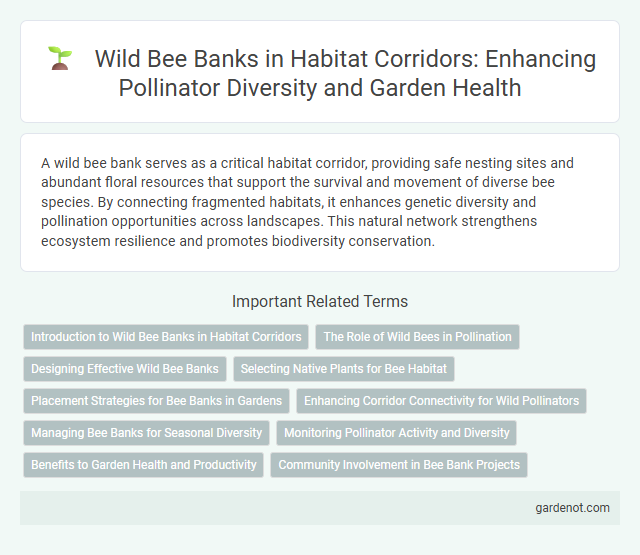A wild bee bank serves as a critical habitat corridor, providing safe nesting sites and abundant floral resources that support the survival and movement of diverse bee species. By connecting fragmented habitats, it enhances genetic diversity and pollination opportunities across landscapes. This natural network strengthens ecosystem resilience and promotes biodiversity conservation.
Introduction to Wild Bee Banks in Habitat Corridors
Wild bee banks serve as specialized habitats designed to support the nesting and foraging needs of native wild bee species within habitat corridors. These banks provide essential resources such as diverse floral arrays and nesting materials, promoting pollinator biodiversity and ecosystem resilience. Strategic placement of wild bee banks in habitat corridors enhances connectivity, facilitating gene flow and population stability among fragmented landscapes.
The Role of Wild Bees in Pollination
Wild bee banks play a crucial role in supporting habitat corridors by preserving diverse native bee populations essential for effective pollination. Wild bees contribute to the reproductive success of numerous plant species, enhancing biodiversity and ecosystem resilience within corridor habitats. Their pollination activities facilitate genetic exchange between plant populations, promoting ecological connectivity and sustaining food webs in fragmented landscapes.
Designing Effective Wild Bee Banks
Designing effective wild bee banks involves selecting diverse native flowering plants that provide continuous nectar and pollen sources throughout the growing season. Incorporating varied nesting habitats such as bare soil patches, hollow stems, and dead wood enhances reproductive success and population stability. Strategic location within habitat corridors maximizes connectivity, facilitating bee movement and gene flow essential for resilient wild bee communities.
Selecting Native Plants for Bee Habitat
Selecting native plants for a wild bee bank enhances biodiversity and supports pollinator health by providing essential nectar and pollen sources. Native plant species are adapted to local soil and climate conditions, ensuring better growth and longer bloom periods that align with bee activity cycles. Incorporating a diverse mix of flowering plants from various families boosts habitat connectivity within the habitat corridor, improving foraging efficiency and reproduction rates for wild bees.
Placement Strategies for Bee Banks in Gardens
Strategic placement of wild bee banks in gardens enhances pollinator diversity and supports ecosystem health by providing native bees with optimal nesting habitats. Positioning bee banks in sunny, sheltered areas near flowering plants ensures easy access to forage and protection from predators. Incorporating varied soil types and maintaining undisturbed ground around the banks further promotes successful colonization and reproduction of wild bee populations.
Enhancing Corridor Connectivity for Wild Pollinators
Wild bee banks serve as critical habitat corridors that enhance connectivity for wild pollinators by providing continuous nesting sites and diverse floral resources. These corridors mitigate habitat fragmentation, enabling gene flow and supporting robust pollinator populations essential for ecosystem stability. Effective wild bee bank implementation boosts biodiversity and improves pollination services across agricultural and natural landscapes.
Managing Bee Banks for Seasonal Diversity
Managing wild bee banks involves strategically maintaining diverse floral resources and nesting habitats throughout the year to support seasonal bee populations. Effective habitat corridors integrate varied plant species blooming at different times, ensuring continuous food availability and promoting genetic diversity among native wild bees. Regular monitoring and adaptive management practices enhance colony resilience, stabilizing pollinator networks critical for ecosystem health.
Monitoring Pollinator Activity and Diversity
Wild bee banks play a crucial role in monitoring pollinator activity and diversity by providing controlled habitats that support various bee species essential for ecosystem health. Utilizing advanced tracking technologies and biodiversity assessment methods, these corridors gather critical data on bee population dynamics, foraging behavior, and seasonal fluctuations. Such monitoring efforts help inform conservation strategies, ensuring robust pollinator networks that enhance crop pollination and biodiversity resilience.
Benefits to Garden Health and Productivity
A wild bee bank enhances garden health by promoting pollination, which increases fruit and vegetable yields while supporting plant diversity. It provides a safe habitat for native bees, improving ecosystem resilience and reducing dependency on chemical pollinators. The presence of diverse pollinators in a wild bee bank also helps control pest populations naturally, fostering a balanced garden environment.
Community Involvement in Bee Bank Projects
Community involvement in Wild Bee Bank projects is essential for enhancing pollinator habitats and promoting biodiversity conservation. Local volunteers participate in creating, monitoring, and maintaining habitat corridors that connect fragmented ecosystems, ensuring sustainable wild bee populations. Collaborative efforts with schools, environmental groups, and landowners foster education and stewardship, contributing to the long-term success of bee corridors.
Wild bee bank Infographic

 gardenot.com
gardenot.com